Copyright © 2024 National Association of State Conservation Agencies | All Rights Reserved
PO Box 613 • Stevens Point, WI 54481
715-340-0681

It’s a sneeze-causing, water-guzzling, fire hazard. And Oklahomans have been battling a seemingly never-ending war against the continued creeping invasion of Eastern Redcedar trees into native prairie and rangeland ecosystems.
The Terry Peach North Canadian Watershed Restoration Act, passed in 2023, is facilitating studies on the impacts of Eastern Red cedar, funding the hiring and equipping of cedar eradication technicians for the creation of brush-free zones around communities, and championing the use of prescribed burns as a method of control of the species.
As the lead on the project, the Oklahoma Conservation Commission (OCC) is working with the state’s local Conservation Districts, the Natural Resources Conservation Service, and other partners to implement multiple methods of cedar control.
“If cedar trees could be studied or talked to death, Oklahoma would be brush-free,” says Trey Lam, OCC’s Executive Director. “Extreme drought, low stream flow, dropping aquifers, large damaging wildfires, and loss of grazing range and wildlife habitat have all come together to create a real crisis. Finally, Oklahoma is taking a coordinated approach to fight this invasion.”
Originally begun in the North Canadian River Watershed with four cedar eradication technicians, the project will be expanded this year to include the South Canadian River and Cimarron River Watersheds. With the expansion will come the hiring of six additional technicians, who as local Conservation District employees, will work within their communities to help mitigate wildfire risk by reducing Eastern red cedar fuel loads around infrastructure.
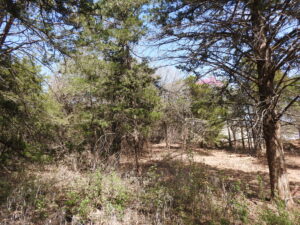
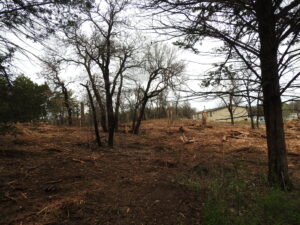
Before and after Eastern red cedars were reduced by technicians.
Eastern red cedar trees, once a minor nuisance, have continued to proliferate across the state. They pose severe risks to the state’s biodiversity, water resources, and community infrastructure. As a fire hazard, the trees contain volatile oils that ignite and burn easily, showering embers downwind which increases the chance of spot fires and rate of fire spread.
Through the project, Prescribed Burn Associations (PBA) and Rural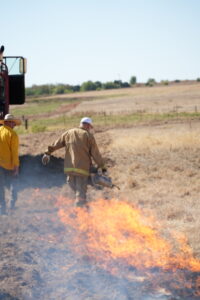 Fire Departments (RFD) are offered trainings and field days on the use of prescribed fire for Eastern Red cedar control. Participating PBAs and RFDs are then eligible for grants to assist with the implementation of control measures.
Fire Departments (RFD) are offered trainings and field days on the use of prescribed fire for Eastern Red cedar control. Participating PBAs and RFDs are then eligible for grants to assist with the implementation of control measures.
“Providing grant funding to rural fire departments and prescribed burn associations is a critical component to incentivize participation in the program,” says Director Lam. “Understandably, there is some resistance to the use of prescribed fire but bringing the PBAs and RFDs together to learn and implement the practice is helping address some of that reluctance.”
The spread of the Eastern red cedar was once controlled by fires, either naturally occurring from lightning or set intentionally by Native Americans. But, increased population, drought, and shifts in land use and management have led to less fire being put on the ground.
Trampas Tripp, OCC Land Management Division Director and a local firefighter himself, knows the value of using prescribed fire as a tool to prevent catastrophic wildfire outbreaks, “Employing different techniques, such as backfiring, to control fire spread not only reduces the loss of life and property but also helps control Eastern Red cedar and restore our grasslands.”
Another important element of the program is the 10,000 acre parallel watershed research study that will be conducted with assistance from the Oklahoma Conservation Commission’s Water Quality Division. Using GIS data, two 5,000 acre tracts with similar topography and cedar population levels have been identified – one tract will be treated using fire and mechanical control; the other tract will be left untreated. The study will seek to identify best management practices for Eastern Red cedar in native rangeland ecosystems.
As a water-guzzler, a 12-inch diameter tree can use up to 42 gallons a day. And Eastern Red cedars degrade watershed quality by increasing the amount of bare soil in an area which can lead to an increased potential for erosion.
While not yet a statewide project, response to the program from legislators, the press, conservation groups, and the public has been extremely positive. Director Lam and Mr. Tripp are regularly asked when the program will be available in other areas of the state.
Director Lam anticipates the success continuing, “Already we have communities that are better protected from wildfire and there is real excitement from those who are seeing the work being done. Soon I expect we will be fighting the brush invasion in every Conservation District in the state.”
A local community approach to Eastern Red cedar may prove to be the turning point needed in the ongoing war against this ever-advancing invasive species.
– Written by Clancy Green, District Services Director
Oklahoma Conservation Commission
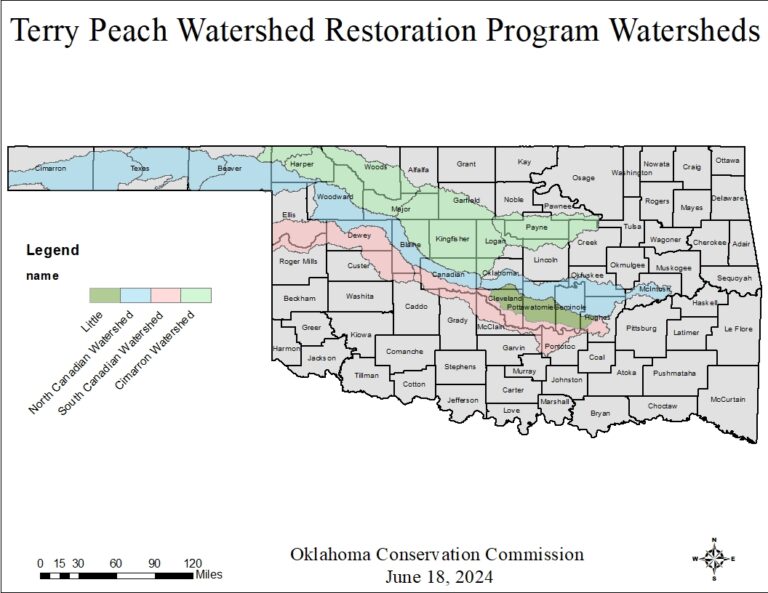
It’s a sneeze-causing, water-guzzling, fire hazard. And Oklahomans have been battling a seemingly never-ending war against the continued creeping invasion of Eastern Redcedar trees into native prairie and rangeland ecosystems.
The Terry Peach North Canadian Watershed Restoration Act, passed in 2023, is facilitating studies on the impacts of Eastern Red cedar, funding the hiring and equipping of cedar eradication technicians for the creation of brush-free zones around communities, and championing the use of prescribed burns as a method of control of the species.
As the lead on the project, the Oklahoma Conservation Commission (OCC) is working with the state’s local Conservation Districts, the Natural Resources Conservation Service, and other partners to implement multiple methods of cedar control.
“If cedar trees could be studied or talked to death, Oklahoma would be brush-free,” says Trey Lam, OCC’s Executive Director. “Extreme drought, low stream flow, dropping aquifers, large damaging wildfires, and loss of grazing range and wildlife habitat have all come together to create a real crisis. Finally, Oklahoma is taking a coordinated approach to fight this invasion.”
Originally begun in the North Canadian River Watershed with four cedar eradication technicians, the project will be expanded this year to include the South Canadian River and Cimarron River Watersheds. With the expansion will come the hiring of six additional technicians, who as local Conservation District employees, will work within their communities to help mitigate wildfire risk by reducing Eastern red cedar fuel loads around infrastructure.
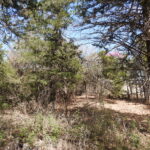
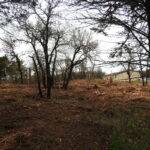
Before and after Eastern red cedars were reduced by technicians.
Eastern red cedar trees, once a minor nuisance, have continued to proliferate across the state. They pose severe risks to the state’s biodiversity, water resources, and community infrastructure. As a fire hazard, the trees contain volatile oils that ignite and burn easily, showering embers downwind which increases the chance of spot fires and rate of fire spread.

Through the project, Prescribed Burn Associations (PBA) and Rural Fire Departments (RFD) are offered trainings and field days on the use of prescribed fire for Eastern Red cedar control. Participating PBAs and RFDs are then eligible for grants to assist with the implementation of control measures.
“Providing grant funding to rural fire departments and prescribed burn associations is a critical component to incentivize participation in the program,” says Director Lam. “Understandably, there is some resistance to the use of prescribed fire but bringing the PBAs and RFDs together to learn and implement the practice is helpingaddress some of that reluctance.”
The spread of the Eastern red cedar was once controlled by fires, either naturally occurring from lightning or set intentionally by Native Americans. But, increased population, drought, and shifts in land use and management have led to less fire being put on the ground.
Trampas Tripp, OCC Land Management Division Director and a local firefighter himself, knows the value of using prescribed fire as a tool to prevent catastrophic wildfire outbreaks, “Employing different techniques, such as backfiring, to control fire spread not only reduces the loss of life and property but also helps control Eastern Red cedar and restore our grasslands.”
Another important element of the program is the 10,000 acre parallel watershed research study that will be conducted with assistance from the Oklahoma Conservation Commission’s Water Quality Division. Using GIS data, two 5,000 acre tracts with similar topography and cedar population levels have been identified – one tract will be treated using fire and mechanical control; the other tract will be left untreated. The study will seek to identify best management practices for Eastern Red cedar in native rangeland ecosystems.
As a water-guzzler, a 12-inch diameter tree can use up to 42 gallons a day. And Eastern Red cedars degrade watershed quality by increasing the amount of bare soil in an area which can lead to an increased potential for erosion.
While not yet a statewide project, response to the program from legislators, the press, conservation groups, and the public has been extremely positive. Director Lam and Mr. Tripp are regularly asked when the program will be available in other areas of the state.
Director Lam anticipates the success continuing, “Already we have communities that are better protected from wildfire and there is real excitement from those who are seeing the work being done. Soon I expect we will be fighting the brush invasion in every Conservation District in the state.”
A local community approach to Eastern Red cedar may prove to be the turning point needed in the ongoing war against this ever-advancing invasive species.
– Written by Clancy Green, District Services Director
Oklahoma Conservation Commission

Copyright © 2024 National Association of State Conservation Agencies | All Rights Reserved
PO Box 613 • Stevens Point, WI 54481
715-340-0681